Great Book on Spectrum Policy
While it has a good section on many of the technical aspects of spectrum policy (Chapter 5 - RF Engineering and Link Budget), the non engineer can set that aside for review as needed. However, the wireless engineering program that wants to use this for a textbook will find that the chapter adds a key part of technical anises that is not normally addressed in electrical engineering education. Many such engineering programs take spectrum policies as coming direct from Mt. Sinai and being immutable. Rather this section shows how technical rules are developed from physical phenomena and estimates of reasonable radio equipment performance which inevitably varies with both equipment cost and progress in technology. A whole chapter is devoted to ITU issues and the parallel recent role of standards development organizations/SDOs. There is a good discussion of the goals of national spectrum management followed by more detail on regulatory arrangements in China, France, UK, and US.
A final chapter on RF safety is more technical than the rest of the book but is a convenient reference to have around when the topic comes up.
While there is discussion of radio propagation in Chapter 5, the focus is on traditional bands and nothing is said about the current "spectrum frontier" of millimeter waves and how the propagation there is so different than the lower traditional bands. But, then again, most spectrum management controversies involved these lower bands. and they will be the interest of most readers. But with that limitation it does an excellent job covering many different aspects of this interdisciplinary field.
Chmn. Wheeler's Speech on Broadband Competition: What Isn't Said About Spectrum Implications

Yesterday, Chairman Wheeler gave a talk entitled The Facts and Future of Broadband Competition” in DC where the above diagram comes from. He introduced the speech as follows:
I want to discuss how the growing bandwidth demands of businesses and consumers are changing the competitive broadband landscape. My goal is not to criticize, but to recognize that meaningful competition for high-speed wired broadband is lacking and Americans need more competitive choices for faster and better Internet connections, both to take advantage of today’s new services, and to incentivize the development of tomorrow’s innovations.
He only uses the word “spectrum” 3 times, on p. 6, in the whole talk:
.Second, where greater competition can exist, we will encourage it. Again, a good example comes from wireless broadband. The “reserve”spectrum in the Broadcast Incentive Auction will provide opportunities for wireless providers to gain access to important low-band spectrum that could enhance their ability to compete. Similarly, the entire Open Internet proceeding is about ensuring that the Internet remains free from barriers erected by last-mile providers.
Third, where meaningful competition is not available, the Commission will work to create it. For instance, our efforts to expand the amount of unlicensed spectrum creates alternative competitive pathways. And we understand the petitions from two communities asking us to pre-empt state laws against citizen-driven broadband expansion to be in the same category, which is why we are looking at that question so closely
We agree with everything he says, but what is telling is what is not said.
The text has the sentence “Today, a majority of American homes have access to 100 Mbps.” This compares well with the statement on p. 9 of the National Broadband Plan (NBP) that “As a milestone, by 2015, 100 million U.S. homes should have affordable access to actual download speeds of 50 Mbps and actual upload speeds of 20 Mbps.” (For reference, Census reports that there are 115,226,802 households in the USA.) Thus at least 57 million homes have access to 100 Mbps, although not necessarily affordable access.
NBP goes on to say
GOAL NO. 3: Every american should have affordable access to robust broadband service, and the means and skills to subscribe if they so choose.
Today’s FCC definition of “broadband” is 4 Mbps which Wheeler calls appropriately “yesterday’s broadband”. He goes on to say, echoing NBP
“high-speed connections are crucial not only for the kind of innovation that will educate our children and deliver quality health care, but also improve energy efficiency, fill the employment ranks, and maintain the United States as the world’s innovation leader for the 21st Century.”
Inside sources tell us that early drafts of NBP mention the impact of this on spectrum: If everyone in the US had access to broadband, even 25 Mbps - already, according to the Chairman on p. 3, 80% have access at some price - why would we the need over the air (OTA) DTV in urbanized areas? The motive for introducing universal broadband is NOT to replace OTA DTV, but rather to move our economy and society forward.
Readers may recall our January 2012 piece on Justice Alito’s comment on OTA DTV during oral arguments:
Unfortunately FCC commissioners are not allowed to make such comments publicly for fear of offending NAB. They even stripped the topic out of the NBP after an early draft leaked to broadcast interests (apparently from 8th Floor sources) and they started getting calls from Congress.
Note that we are not necessarily advocating moving more spectrum from broadcasting to cellular, rather we are saying that the large broadcasting allocations will become more and more untenable as a matter of public policy as broadband penetration increases. This could be accelerated if “free TV” for lower income households could be replaced through freemium basic cable-like service over Internet. All household would be better off with effective broadband. Pumping hundreds of thousands of watts of RF power over several MHz from large transmitter towers in order to qualify for retransmission consent or must-carry could become “so 20th century”! We do not wish the financial demise of the NAB membership, the incentive auction gives them one way to monetize their long term investment.
Your blogger joined FCC spectrum management 35 years ago this month. The world of spectrum use has change considerably in those 35 years with cellular, impact of cellular frequency reuse permitting spectrum productivity that seemed impossible, the upper band of permitted spectrum at 95 GHz, spectrum efficiencies that exceed 1 bps/Hz, DTV, etc. The increasing concentration of spectrum in cellular companies may not be optimal for our society and economy with respect to new spectrum needs we do not understand today just as in 1979 FCC did not appreciate what was coming, e.g. Part 90 was seen as needing much more spectrum then.
While we think that the military needs to be more flexible about its spectrum needs and sharing with the private sector, the US has the largest and most information intensive military in the world and recent events show that for the foreseeable future we face more national security threats that most countries represented in 3GPP. Thus while we may be able to downside or eliminate the need for OTA DTV as broadband penetration reaches new goals, we should not necessarily hand over the spectrum in a way that can not be readily reversed to systems designed in 3GPP for other markets.
NAB should not be able to veto dialogue on the spectrum impacts of broadband penetration just as CTIA should not be able to demand every Hz that “isn’t nailed down”.
UPDATE
As if on cue, the day after this was posted, our home town newspaper had an article entitled “TV is increasingly for old people”. The beginning of the article stated:
The median age of a broadcast or cable television viewer during the 2013-2014 TV season was 44.4 years old, a 6 percent increase in age from four years earlier. Audiences for the major broadcast network shows are much older and aging even faster, with a median age of 53.9 years old, up 7 percent from four years ago.
These television viewers are aging faster than the U.S. population, Nathanson points out. The median age in the U.S. was 37.2, according to the U.S. Census, a figure that increased 1.9 percent over a decade. So to put that in context of television viewing, he said TV audiences aged 5 percent faster than the average American.
Of the networks, Fox has the youngest average viewer age at 47.8 years while CBS has the oldest at 58.7 years. Broadcasting & Cable, the industry’s cheerleader published a similar article on the new data.
FM Broadcast -> 700 MHz LTE Interference Problem Reveals Basic FCC Spectrum Policy Problems
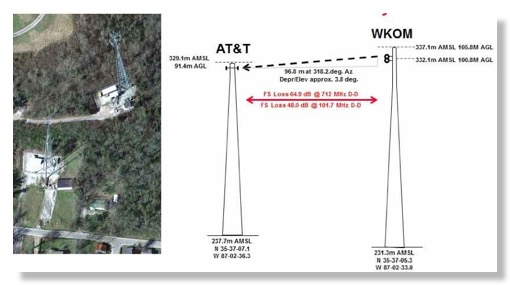
On June 25, 2013 our friends at CommLawBlog published a surprising post that has not received much attention. It was entitled “Harmonic Convergence? FM Interference to 700 MHz LTE Service” and was authored by Peter Tannenwald.
The post starts:
The introduction of different species into an established ecosystem tends to be a dicey proposition. Almost invariably, co-habitation requires the sharing of scarce resources. And more often than not, the different species approach the whole sharing thing in different, not entirely compatible, ways. The result: occasional dissatisfactions and frustrations – leading to occasional inter-species frictions and fisticuffs.
Take the RF spectrum ecosystem, for example.
Most inhabitants of the spectrum have historically figured out ways to coexist in relative peace (at least for the most part) – thanks largely to the fact that the potential impact of one service on another has been taken into account in the frequency allocation process. But as the demand for spectrum increases, and every little niche is filled up, it is becoming more difficult to avoid inter-service conflicts. And sure enough, the introduction of a recent new species – 700 MHz wireless systems using LTE equipment – seems to be causing some unexpected problems.
The post goes on to describe an emerging problem of interference from FM broadcast stations to 700 MHz cellular base stations nearby. A search of the FCC website on this issue found no public documents on the FCC’s voluminous website dealing with this issue. Fortunately Google found several non-FCC documents published after Mr. Tannenwald’s breaking post.
Barry Mishkind at The Broadcasters' Desktop Resource (BDR) published a report on June 28, 2013 that is linked to a detailed technical discussion of the issue. The public trail of this event appears to begin on 6/19/13 with the issuance of a Notice of Violation* by the FCC’s Enforcement Bureau’s New York District Office to WKZE-FM in Salisbury CT. The NOV alleges that their signal on 98.1 MHz had an 8th harmonic at 784.8 MHz that was causing interference to a VZW base station located approximately 500 feet away. The NOV cited 73.317(a):
(a) FM broadcast stations employing transmitters authorized after January 1, 1960, must maintain the bandwidth occupied by their emissions in accordance with the specification detailed below. FM broadcast stations employing transmitters installed or type accepted before January 1, 1960, must achieve the highest degree of compliance with these specifications practicable with their existing equipment. In either case, should harmful interference to other authorized stations occur, the licensee shall correct the problem promptly or cease operation. (Emphasis added.)
A major issue here is whether the above clear rule take precedent over the Commission’s general “first in time, first in right philosophy”** that is stated neither in the law nor as a general codified rule. We will leave it to our legal friends to parse case law on this issue.
Clearly the NAB crowd and the CTIA crowd have a major difference in viewpoint here. NAB’s past quixotic attempts to require all cell phones to have FM receivers certainly is not helping these industry giants’ mutual relationship, especially at this time of incentive auction focus by all.
We have not seen any public statements from the cellular community on this issue, so Scott Baxter’s comprehensive 10/13 presentation to the Association of Federal Communications Consulting Engineers, a mainly broadcast engineering group, is the most definitive discussion of the technical issue on the public record. (Scott’s usual clients appear to be mostly wireless firms.)
It is unclear what the technical problem here really is, although there seems no controversy that the FM transmitter in question meets the numeric out of band emission limits of § 73.317(d):
(d) Any emission appearing on a frequency removed from the carrier by more than 600 kHz must be attenuated at least 43 + 10 Log10 (Power, in watts) dB below the level of the unmodulated carrier, or 80 dB, whichever is the lesser attenuation.
Several possible hypotheses:
- This out of band emission level of § 73.317(d) is not adequate to protect 700 MHz LTE base stations x meters away.
- The usual measurement procedure for determining this emission limit may focus too much on the power that goes to the antenna and not enough on incidental leakage from the transmitter cabinets that might have inadequate shielding in some models. (This is consistent with observations in the Baxter briefing.)
- The emission limit is adequate, but loose metal connections in or near the cellular antenna structure generate harmonics from the strong FM signal a few hundred feet away just as intermodulation products are generated in strong electromagnetic fields when there is a dense concentration of transmitters such as Mt. Wilson, CA and Sandia Ridge, NM.
- The cellular base station receivers may be inadequately filtered/shielded and subject to desensitization in strong fields from the FM transmitter hundreds of MHz away. Despite years of talk, FCC still has no general policy on receiver performance issues.
- The IEEE-USA harmful interference white paper, released in July 2012, urges FCC to clarify the issue of “minimum protection distance” with respect to all interference issues since generally any receiver will get interference if it gets too close to a transmitter. While there are clear precedents for a few cases such as personal computers near TV receivers and UWB devices near PCS cell phones, FCC has no general position on this issue or even a process to determine minimum protection distance. Thus the cellular interests will say there is should be no interference at 500 feet and the broadcaster will disagree.
- Rather than keeping this issue off the public agenda, as it has so far except for the difficult to find NOV, FCC should be engaging industry experts in an open and transparent way. This highlights one of the problems of the FCC’s Technological Advisory Committee (TAC): it is not set up to handle this type of problem as it consists mostly of technical policy managers of key players, not the technical experts in the area (National Academy of Engineering members and IEEE Fellows are rare) and meets infrequently. Thus there is no indication of any TAC involvement to date as this problem threatens LTE roll outs. Note that another IEEE-USA 2012 product, “Position Statement on Improving U.S. Spectrum Policy Deliberations in the Period 2013-2017” addressed the issue of improving advisory function based on best practices of other regulatory agencies with technical jurisdiction:
FCC and NTIA should supplement their existing Technological Advisory Council (TAC) and Commerce Spectrum Management Advisory Committee (CSMAC), which consist mainly of representatives of major communications firms, with a new advisory committee that serves both agencies and focuses on independent review of options for resolving spectrum conflicts and identifying outdated policies. The new group should be modeled on the EPA Science Advisory Board and the NRC Advisory Committee on Reactor Safeguards and members should have the necessary security clearances to deal with issues involving classified federal government spectrum users, if so requested.
- “Emerging interference” has been a recurring topic in this blog. In our dynamic wireless industry it is not surprising the new and unexpected interference mechanism appear in practice and need timely attention, for the bigger they become they usually become harder to solve. But for decades FCC has had no mechanism for dealing with emerging interference issues. Thus the police radar detector interference to VSAT receivers took more than a decade to resolve (the official FCC records “fuzzify” the starting date of the problem) and the “cellular booster” issue took 6+ years. FCC needs a generic and transparent problem for identifying such issues promptly and for engaging the public on which need urgent attention and which deserve “benign neglect”. For example, home TV antennas with built-in amplifiers, rare prior to DTV, are a recurring source of interference to TV and other services at a modest rate and it is marginal whether the issue needs regulatory attention at this time. But how many top FCC managers and 8th Floor residents are aware of this and other emerging issues?
- This is closely related to the reason why the Commission’s Spectrum Policy Task Force originally raised the issue of “interference temperature” a decade ago. The goal was to define better what environment systems should expect in practical operation. It may well be that the designers of these base station never considered an environment with a strong FM signal present from a nearby transmitters. But the NOI/NPRM in Docket No. 03-237 was so poorly and confusingly written that FCC closed the docket in 2007 and has never expressed any further interest in the issue. Whether or not interference temperature is ever used as a basis for allowing more unlicensed use, quantifying expectation really would help incumbents and would allow timely resolution of controversies such as this FM/LTE one.
Your blogger has filed a FOIA request with FCC seeking all correspondence on this issue with outside parties relating to the NOV. It does not seek internal FCC documents that have various FOIA exemptions. These documents will be posted here as soon as they are available. However, unless they embarrass Rupert Murdoch, that probably won’t be soon.
* The NOV URL given is from the FCC website, BUT we have found no way to get there unless you happen to have bookmarked the URL for Notices of Violation and Notices of Unlicensed Operation issued by Field Offices or the Enforcement Bureau’s old home page - no longer linked to the main FCC website.
** - The “newcomer” policy dates back to Midnight Sun Broadcasting Co., Memorandum Opinion and Order, 11 FCC 1119 (1947), in which the Commission held a broadcaster responsible for resolving interference caused by its new facilities to other preexisting facilities in close proximity. See FCC 13-115 at para. 4 and fn. 7
UPDATE
In a tweet responding to this post, Brett Glass hypothesized “FM could be hitting inadequately shielded IF stages in LTE equipment.”
Dueling Spectrum Charts - Part 2
Fred Campbell, who during the Chmn. Martin era was the chairman’s wireless advisor and then Chief of WTB, has written a blog post on the new FCC spectrum chart report. Fred questions the consistency of the new data with earlier FCC statements in the merger context:
“It appears that the FCC considers the entire 194 MHz of licensed spectrum in the 2.5 GHz band as available for mobile broadband in the US when the ratio of licensed to unlicensed spectrum and international pride are at stake, but only 55 MHz is available when the FCC considers the impact of licensed spectrum aggregation on mobile competition. If the 139 MHz of spectrum the FCC excludes from its calculations when considering mergers is excluded from the international comparison in Table 1 of the report, the total licensed spectrum in the US that is available for mobile broadband drops from 608 to 469 MHz.”
Fred ends his post with
An exercise for readers is to decide whether the Martin chairmanship was any better on being “focused . . . on facts and data”.An agency that is truly “focused . . . on facts and data” would not pretend otherwise by manipulating facts and data to satisfy its desired results. Sadly, over the last three years, the FCC has demonstrated it is no such agency.
Your blogger was in Japan last week for some speaking engagements. In a talk at ARIB he pointed out the inconsistency of the FCC’s number for Japanese mobile spectrum (500 MHz) and CTIA’s number (347 MHz) and asked which was correct. Fortunately ARIB had just finished a report, in Japanese only, on wireless spectrum use in Japan. The key chart from that report is shown below and indicates 501.2 MHz of commercial mobile spectrum at the moment. So on this point, score 1 for FCC.
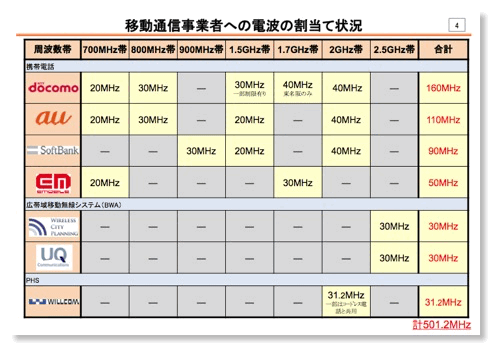
On Fred Campbell’s point, I don’t follow merger issues too closely so I would welcome input from others on who is correct.
(I would be glad to share the ARIB report with others who are interested and can digest the Japanese in it.)
UPDATE
Pierre de Vries, in his Deep Freeze 9 blog, has expanded on this post with respect to alternative ways to quantify spectrum use.
Dueling Spectrum Charts
Like the “dueling banjos” scene in Deliverance, we now have dueling spectrum charts with the release this week of the FCC White Paper The Mobile Broadband Spectrum Challenge: International Comparisons, produced jointly by WTB and OET.
Reader may recall the recent criticism here of CTIA’s long used chart shown below:
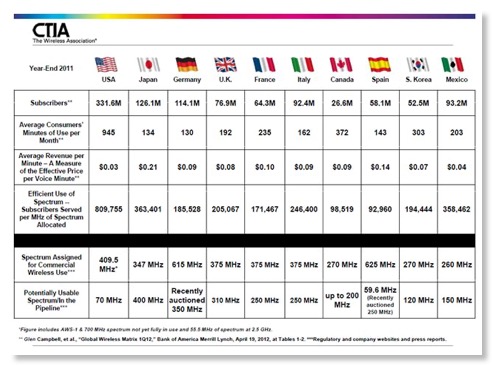
Now FCC has answered back with its own accounting of international mobile spectrum use:
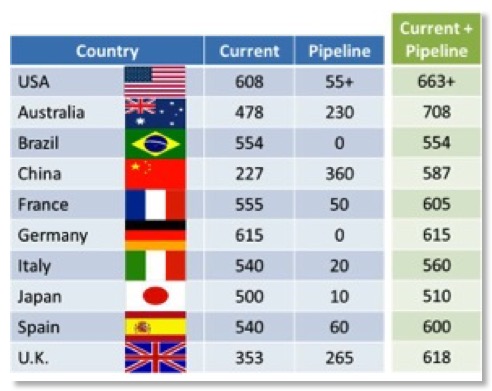
Now FCC does not use the absurd CTIA metric of “subscribers served per MHz of spectrum allocated” previously discussed here. And FCC adds data on unlicensed spectrum, often used by the cellular establishment for offloading traffic and thus improving service but almost always opposed by the cellular industry.

Clearly there are some major difference between CTIA’s accounting and FCC’s. For example FCC finds 608 MHz of “mobile broadband” spectrum now in the US, while CTIA can only find 409.5 MHz of “spectrum assigned for commercial wireless use”. At least in the UK the numbers are closer, FCC finds 353 MHz while CTIA finds 375 MHz. In the case of Japan, FCC finds 500 MHz of spectrum while CTIA can only find 347 MHz.
Hopefully both sides will explain what exactly they added up to get to the bottom of this disagreement. However, in the country with the world’s largest most information intensive military and with a severe post 9/11 public safety problem, it should not be surprising that less spectrum is available for commercial wireless then in, say, Brazil. If the cellular community was more open to spectrum sharing, rather than just trashing the PCAST report sharing recommendations, we could have more commercial wireless use as well as public safety/defense use.
That CTIA Flag Chart

For at least 2 years CTIA has been using the above chart, including minor variations, as part of its justifications for more allocations for cellular licensees. Your blogger does not disagree with the basic need for such allocations.
But it is interesting to look at the logic of this chart. Note the 3rd row “Efficient Use of Spectrum -- Subscribers Served per MHz of Spectrum Allocated”. In the US the value is 809,722 while in Spain it is on 92,960. Wow, Spain must be a great place!
Now let’s extend this logic. Let’s take the CIA World Factbook as a source of population data. Vatican City has a population 826 and has the same 375 MHz cellular allocation as Italy, so it has an “Efficient Use of Spectrum” of 825/375 or 2.2. They must have great cellular connectivity! Cellular nirvana.
How about San Marino, population 32,140 with an “Efficient Use of Spectrum” of 85.7 Supernirvana!
Click map to enlarge
Think these are too obscure? Luxembourg is a founding member of NATO and has a population of 509,074, giving an “Efficient Use of Spectrum” of 1358. So if you want great mobile service and don’t want the limits of living in the Vatican or San Marino, move to Luxembourg! (I’ve been there! The local wines are also great.)
The real point is that spectrum efficiency really is important. But spectrum lobbyists are reducing arguments to absurdity by trivializing technical issues in the high stakes game of spectrum allocations. It is amazing that CTIA has used this nonsensical metric for so long and it reflects on both CTIA and many of the government officials they deal with that they have been able to use such garbled thinking for so long.
Spectrum efficiency is generally thought of including more than population and amount of spectrum, area is a key issue. Frankly, it doesn’t make much sense to deal on spectrum efficiency with a country as a whole, since demand varies greatly in different areas in countries larger than Vatican City. A much better metric is peak population/area/MHz.
Now maybe this is too confusing for spectrum lobbyists and the officials that they deal with, but misleading information like the “flag chart” detracts from the real issues.
Can’t we have a spectrum dialogue with real facts, not phony metrics made up by spectrum lobbyists and PR firms?
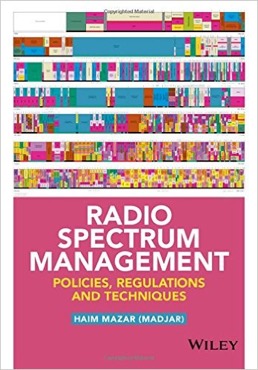

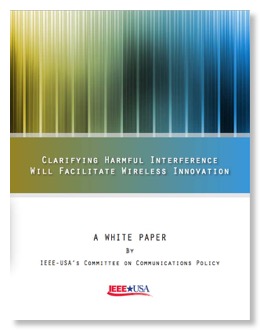
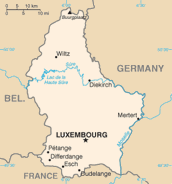



![Validate my RSS feed [Valid RSS]](valid-rss-rogers.png)

